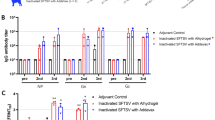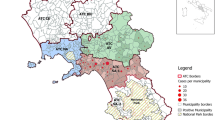Abstract
Bluetongue (BT) is an infectious, non-contagious, insect-transmitted viral disease of sheep, other domestic, and wild ruminants caused by bluetongue virus (BTV), a prototype species of the genus Orbivirus of the family Reoviridae. The study was designed to determine the hematological and biochemical alterations and acute phase protein response in BTV sero-negative sheep experimentally infected with bluetongue virus serotype-10 and 24. The BTV-infected group comprising of 18 animals, 6 each inoculated with 6 ml of clarified virus containing 1 × 106/ml TCID50 of BTV-10 or 24 by intradermal route, 6 animals inoculated with equal volumes of BTV-10 and 24 and 4 animals with 6 ml of mock infected culture fluid served as uninfected control group. The blood and serum samples were analyzed at 0, 1, 3, 7, 11, and 16 days post-infection (DPI). Hematological findings in this study showed a significant decrease in the total number of white blood cells in BTV-10 infected group, a significant increase in circulating neutrophils decrease in lymphocytes in all the infected groups, in PCV in BTV-24 and co-infected groups, and RBC count in only BTV-24-infected group at 11 DPI. The results of serum biochemical analyses of alanine aminotransferase (ALT), aspartate aminotransferase (AST), and alkaline phosphatase (ALP) exhibited increased levels in BTV-24 and co-infected animals. A significant rise in the serum level of creatine kinase (CK) was observed from 3 DPI in the infected groups. Serum levels of total proteins decreased significantly at 11 DPI in BTV-24 infected animals. Significant increase in CRP and fibrinogen levels was observed at 7 and 11 DPI in the infected groups. The significantly decreased levels of TLC, hemoglobin, PCV, CK, and acute phase proteins such as fibrinogen and CRP indicated the inflammatory changes associated with the virus replication and the consequent vascular damage and inflammatory changes in the tissues. Further, the variations in the hemato-biochemical and acute phase response observed between the two serotypes BTV-10 and 24 probes to the difference in virulence and pathogenesis of the serotypes in infected sheep.



Similar content being viewed by others
References
Aytekin I, Aksit H, Sait A, Kaya F, Aksit D, Gokmen M, Baca AU (2015) Evaluation of oxidative stress via total antioxidant status, sialic acid, malondialdehyde and RT-PCR findings in sheep affected with bluetongue. Vet Rec open 2(1):e000054
Babu YH (1985) Haematological studies of bluetongue disease in sheep. Indian Vet J 62:828–831
Balaro MFA, dos Santos Lima M, Del Fava C, de Oliveira GR, Pituco EM, Brandão FZ (2014) Outbreak of bluetongue virus serotype 4 in dairy sheep in Rio de Janeiro, Brazil. J Vet Diagn Investig 26(4):567–570
Bommineni YR, Reddy YN, Rao PP, Sudheer D, Susmitha B, Sarma BJ, Rao S (2008) Isolation of bluetongue virus serotypes 2, 9 and 15 from sheep in India. Vet Record 163:545–546
Bumbarov V, Golender N, Erster O, Khinich Y (2016) Detection and isolation of bluetongue virus from commercial vaccine batches. Vaccine 34(28):3317–3323
Ellis JA, Luedke AJ, Davis WC, Wechler SJ, MacLachlan NJ, Pratt DL, Elloit JD (1990) T. lymphocyte subset in sheep and cattle. Vet Immunol Immunopathol 24:49–67
Hirvonen J, Pyorala S, Jousimies-Somer H (1996) Acute phase response in heifers with experimentally induced mastitis. J Dairy Res 63:351–360
Howerth EW, Greene CE, Prestwood AK (1988) Experimentally induced bluetongue virus infection of white-tailed deer: clinical, pathologic and gross pathologic changes. Am J Vet Res 49:1906–1913
Jain S, Gautam V, Naseem S (2011) Acute-phase proteins: as diagnostic tool. J Pharm Bioallied Sci 3(1):118–127
Jeggo MH, Corteyn AH, Taylor WP, Davidson WH, Gorman BM (1986) Virulence of bluetongue virus for British sheep. Res Vet Sci 42:24–28
Krishnajyothi Y, Maan S, Kandimalla K, Maan NS, Tutika RB, Reddy YV, Kumar A, Mrunalini N, Reddy GH, Putty K, Ahmed SM (2016) Isolation of bluetongue virus 24 from India—an exotic serotype to Australasia. Transbound Emerg Dis 63(4):360–364
Luedke AJ, Bowne JG, Jochim MM, Doyle C (1964) Clinical and pathologic features of bluetongue in sheep. Am J Vet Res 25:963
Maan S, Maan NS, Nomikou K, Veronesi E, Bachanek-Bankowska K, Belaganahalli MN, Attoui H, Mertens PP (2011) Complete genome characterisation of a novel 26th bluetongue virus serotype from Kuwait. PLoS One 6(10):e26147
MacLachlan NJ, Jagels G, Rossitto PV, Moore PF, Heidner HW (1990) The pathogenesis of experimental bluetongue virus infection of calves. Vet Pathol 27(4):223–229
MacLachlan NJ, Crafford JE, Vernau W, Gardner IA, Goddard A, Guthrie AJ, Venter EH (2008) Experimental reproduction of severe bluetongue in sheep. Vet Path 45(3):310–315
Maclachlan NJ, Drew CP, Darpel KE, Worwa G (2009) The pathology and pathogenesis of bluetongue. J Comp Pathol 141(1):1–16
Marmor AT, Klein R, Plich M, Groshar D, Schneeweiss A (1988) Elevated CK-MB isoenzyme after exercise stress test and atrial pacing in patients with ischemic heart disease. Chest. 94(6):1216–1220
McColl KA, Gould AR (1994) Bluetongue virus infection in sheep: haematological changes and detection by polymerase chain reaction. Aust Vet J 71(4):97–101
Mishra S (1992) Studies on the characterisation and properties of a field isolate of bluetongue disease virus. M.V.Sc. thesis submitted to deemed university, I.V.R.I., Izatnagar, UP
Odeón AC, Schore CE, Osburn BI (1997) The role of cell-mediated immunity in the pathogenesis of bluetongue virus serotype 11 in the experimental infection of vaccine/sensitized calves. Comp Immunol Microbiol Infect Dis 20(3):219–231
Rao PP, Hegde NR, Reddy YN, Krishnajyothi Y, Reddy YV, Susmitha B, Gollapalli SR, Putty K, Reddy GH (2016) Epidemiology of bluetongue in India. Transbound Emerg Dis 63(2):e151–e164
Reddy YKM, Manohar BM, Pandey AB, Reddy YN, Prasad G, Chauhan RS (2010) Development and evaluation of inactivated pentavalent adjuvanted vaccine for bluetongue. Indian Vet J 87(5):434–436
Reed LJ, Muench H (1938) A simple method for estimating fifty percent endpoints. Am J Hyg 27:493–497
Saminathan M, Rana R, Ramakrishnan MA, Karthik K, Malik YS, Dhama K (2016) Prevalence, diagnosis, management and control of important diseases of ruminants with special reference to Indian scenario. J Exp Biol Agric Sci 4(3S):338–367
Sanchez-Cordon PJ, Pleguezuelos FJ, Perez de Diego AC, Gomez-Villamandos JC, Sanchez-Vizcaino JM, Ceron JJ, Tecles F, Garfia B, Pedrera M (2013) Comparative study of clinical courses, gross lesions, acute phase response and coagulation disorders in sheep inoculated with bluetongue virus serotype 1 and 8. Vet Microbiol 166:184–194
Singh KP, Umeshappa CS, Ahmed KA, Pandey AB (2008) Haematological and biochemical responses in native sheep experimentally infected with bluetongue virus serotype-23. Ind J Anim Sci 78:8–12
Sproston NR, Ashworth JJ (2018) Role of C-reactive protein at sites of inflammation and infection. Front Immunol 9
Sun EC, Huang LP, Xu QY, Wang HX, Xue XM, Lu P, Li WJ, Liu W, Bu ZG, Wu DL (2016) Emergence of a novel bluetongue virus serotype, China 2014. Transbound Emerg Dis 63(6):585–589
Thomas JS (2000) Overview of plasma proteins. In: Feldman BF, Zinkl JG, Jain NC (eds) Schalm’s veterinary hematology. Lippincott Williams & Wilkins, Philadelphia, pp 891–898
Tothova C, Nagy O, Kovac G (2016) Serum proteins and their diagnostic utility in veterinary medicine: a review. Vet Med - Czech 61(9):475–496
Umeshappa CS, Singh KP, Nanjundappa RH, Pandey AB (2010) Apoptosis and immuno-suppression in sheep infected with bluetongue virus serotype-23. Vet Microbiol 144:310–318
Umeshappa CS, Singh KP, Channappanavar R, Sharma K, Nanjundappa RH, Saxena M, Singh R, Sharma AK (2011) A comparison of intradermal and intravenous inoculation of bluetongue virus serotype 23 in sheep for clinico-pathology, and viral and immune responses. Vet Immunol Immunopathol 141(3–4):230–238
Wright IM (2014) Serological and genetic characterisation of putative new serotypes of bluetongue virus and epizootic haemorrhagic disease virus isolated from an Alpaca (Doctoral dissertation, North-West University)
Acknowledgments
We thank Director, Joint Directors and Head, Department of Pathology, ICAR-IVRI for providing all the facilities to carry out this research work.
Funding
This study was supported by research grant from AINP-BT (Grant No. 3(8)/98 ASR-IV, dated 23 March 2001) and DBT-BBSRC (Grant No. BT/IN/Indo-UK/FADH/46/SM/2013, dated 8 September 2014), CADRAD, ICAR-IVRI, Uttar Pradesh, India.
Author information
Authors and Affiliations
Corresponding author
Ethics declarations
Conflict of interest
The authors declare that they have no conflict of interest.
Ethical approvals
All procedures performed in studies involving animals were in accordance with the ethical standards of the institution or practice at which the studies were conducted. Experimental animals used for this research have been approved by the IAEC (ICAR-IVRI) and CPCSEA with Ethical Clearance Certificate’s Number: 25/21/2017-CPCSEA dated 20 October 2017.
Additional information
Publisher’s note
Springer Nature remains neutral with regard to jurisdictional claims in published maps and institutional affiliations.
Rights and permissions
About this article
Cite this article
Sobharani, V., Singh, K.P., Maity, M. et al. Comparative study on hemato-biochemical alterations and selected acute phase protein response in native sheep experimentally infected with bluetongue virus serotypes 10 and 24. Comp Clin Pathol 28, 1153–1163 (2019). https://doi.org/10.1007/s00580-019-02950-x
Received:
Accepted:
Published:
Issue Date:
DOI: https://doi.org/10.1007/s00580-019-02950-x




